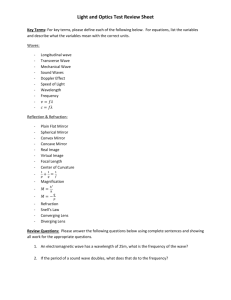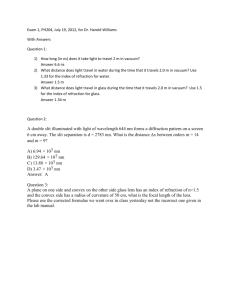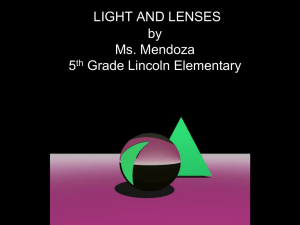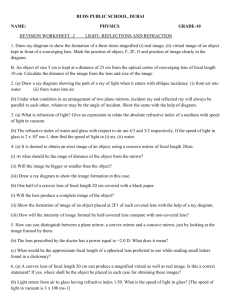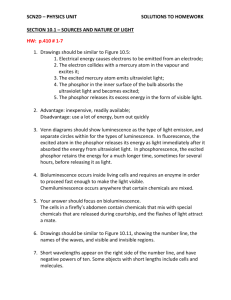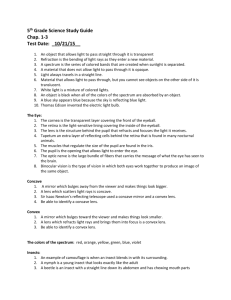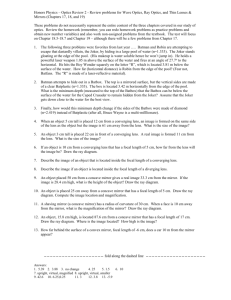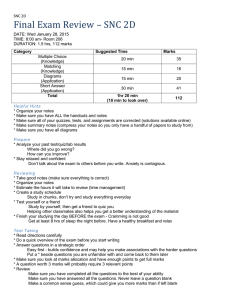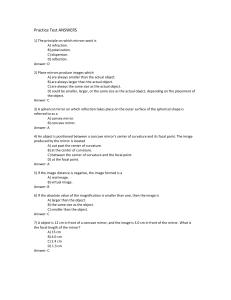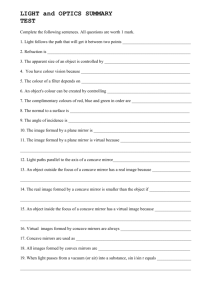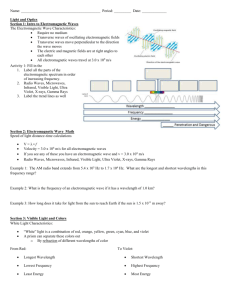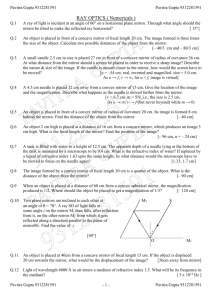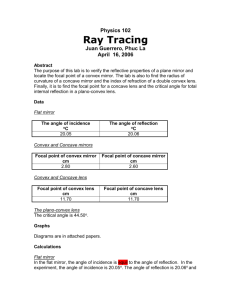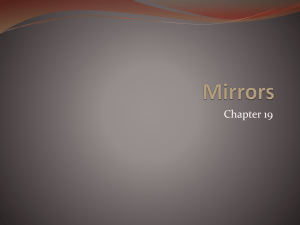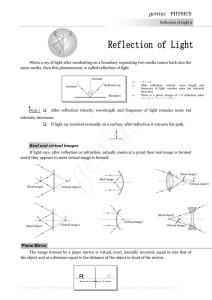The Nature of Light & Colour
advertisement
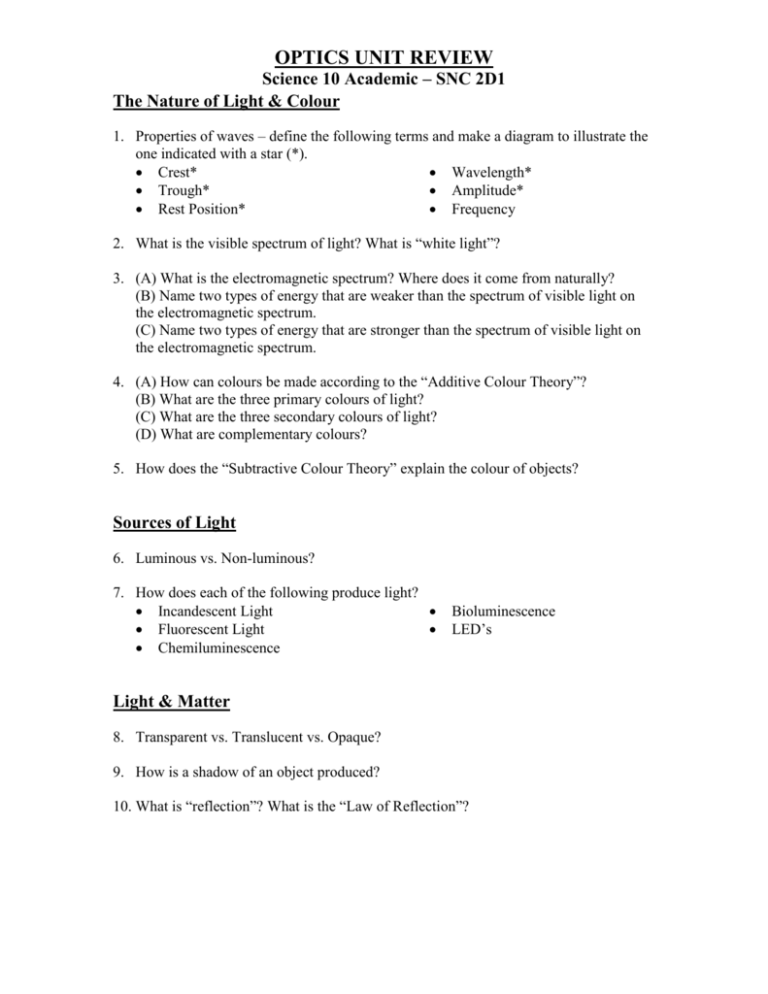
OPTICS UNIT REVIEW Science 10 Academic – SNC 2D1 The Nature of Light & Colour 1. Properties of waves – define the following terms and make a diagram to illustrate the one indicated with a star (*). Crest* Wavelength* Trough* Amplitude* Rest Position* Frequency 2. What is the visible spectrum of light? What is “white light”? 3. (A) What is the electromagnetic spectrum? Where does it come from naturally? (B) Name two types of energy that are weaker than the spectrum of visible light on the electromagnetic spectrum. (C) Name two types of energy that are stronger than the spectrum of visible light on the electromagnetic spectrum. 4. (A) How can colours be made according to the “Additive Colour Theory”? (B) What are the three primary colours of light? (C) What are the three secondary colours of light? (D) What are complementary colours? 5. How does the “Subtractive Colour Theory” explain the colour of objects? Sources of Light 6. Luminous vs. Non-luminous? 7. How does each of the following produce light? Incandescent Light Fluorescent Light Chemiluminescence Bioluminescence LED’s Light & Matter 8. Transparent vs. Translucent vs. Opaque? 9. How is a shadow of an object produced? 10. What is “reflection”? What is the “Law of Reflection”? OPTICS UNIT REVIEW Science 10 Academic – SNC 2D1 Mirrors 11. Plane vs. Concave vs. Convex? (Also – Converging and Diverging Mirrors?) 12. (A) Draw a ray diagram (with five light rays) show light striking a plane mirror? (B) Draw a ray diagram (with five light rays) show light striking a concave mirror? (C) Draw a ray diagram (with five light rays) show light striking a convex mirror? 13. Define the following terms – show a diagram of the ones indicated with a star (*). Focal Point Primary Axis Focal Length Vertex Centre of Curvature 14. You must be able to locate the image of an object placed at various lengths in front of a concave mirror? (Review in-class activity and handout.) 15. You must be able to locate the image of an object placed in front of a convex mirror? (Review in-class activity and handout.) 16. Name three uses for concave mirrors and three uses for convex mirrors. 17. Calculating magnification – review problems on pages 424-425. Refraction 18. (A) What does “refraction” mean? (B) Why does light refract? 19. Calculating the refractive index for a substance OR the speed of light through that substance using the Refractive Index – review problems on page 438. 20. The speed of light in a vacuum is 3.00 x 108 m/s. If the speed of light passing through liquid bromine is 1.8 x 108 m/s, what is the refractive index of liquid bromine? Please show your work to receive marks. 21. The speed of light in a vacuum is 3.00 x 108 m/s. If the speed of light passing through an unknown crystal is 1.55 x 108 m/s, what is it’s refractive index? 22. The index of refraction of air is 1.00, and the index of refraction of water is 1.33. Use Snell’s law to determine the angle of refraction when light enters a pool of water at an angle of incidence of 38° from the normal. 23. The index of refraction of air is 1.00. When light enters a medium at an angle of incidence of 38° from the normal, the angle of refraction is 31°. Find the index of refraction of the medium. OPTICS UNIT REVIEW Science 10 Academic – SNC 2D1 LENSES 24. (A) Describe and illustrate light rays (5 of them) passing through a concave lens. (B) Describe and illustrate light rays (5 of them) passing through a convex lens. 25 .Define and illustrate the terms: Optical centre Axis of symmetry Principal axis Focal point 26. A lens produces a real image that is 15 times bigger than the object. If the object is 13 cm away, how far away is the image? 27. A magnifying glass will magnify 8 times. If the magnifying glass is held over a page and magnifies an object than is 11 cm tall, how big is the image? 28. You must be able to locate the image of an object placed in front of a concave lens? (Review in-class notes and examples.) 29. You must be able to locate the image of an object placed at various lengths in front of a convex lens? (Review in-class notes and examples.) 30. Sketch a concave mirror ray diagram of an arrow located 2.5 focal lengths from the mirror. Label the focal point, focal length, vertex, principal axis, height of the object, and height of the image. Also indicate the other characteristics of the image (LOST). 31. Sketch a convex mirror ray diagram of an arrow located 1.5 focal lengths from the mirror. Label the focal point, focal length, vertex, principal axis, height of the object, and height of the image. Also indicate the other characteristics of the image (LOST). Human Perception of Light 32. State the functions of the various parts of the eye. 33. What are the two types of photoreceptors? 34. Explain the terms far-sighted and near-sighted. What types of lens are used to correct for those who are far-sighted and near-sighted? 35. Explain the terms: colour blindness, colour vision deficiency, antigmatism. Technologies that Use Light 36. What is the difference between a shutter and an aperture? 37. What is the difference between a telephoto lens and a wide-angle lens? OPTICS UNIT REVIEW Science 10 Academic – SNC 2D1 38. What is the advantage and disadvantage of a widespread camera use? 39. What lenses are used in compound microscope? 40. What are two main types of telescopes? 41. Why is the image you view through a microscope upside down?
